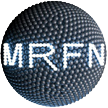The Bruker Dimension Edge AFM measures nanometer-scale microscopy by rastering (over a surface of interest) a sharp probe, the z-position of which is controlled in a closed-loop feedback on a measure of the atomic forces on the probe by the surface. These forces are strongly dependent on the probe-surface distance, and so the z-adjustments required to maintain constant force during rastering are directly related to the topographical and morphological features.



